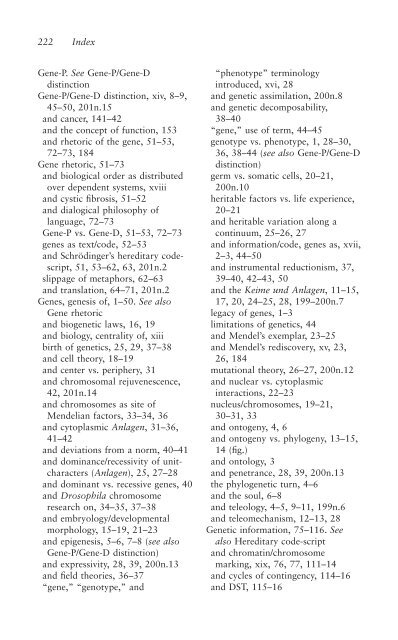A Critique of Pure (Genetic) Information
A Critique of Pure (Genetic) Information
A Critique of Pure (Genetic) Information
You also want an ePaper? Increase the reach of your titles
YUMPU automatically turns print PDFs into web optimized ePapers that Google loves.
222 Index<br />
Gene-P. See Gene-P/Gene-D<br />
distinction<br />
Gene-P/Gene-D distinction, xiv, 8–9,<br />
45–50, 201n.15<br />
and cancer, 141–42<br />
and the concept <strong>of</strong> function, 153<br />
and rhetoric <strong>of</strong> the gene, 51–53,<br />
72–73, 184<br />
Gene rhetoric, 51–73<br />
and biological order as distributed<br />
over dependent systems, xviii<br />
and cystic fibrosis, 51–52<br />
and dialogical philosophy <strong>of</strong><br />
language, 72–73<br />
Gene-P vs. Gene-D, 51–53, 72–73<br />
genes as text/code, 52–53<br />
and Schrödinger’s hereditary codescript,<br />
51, 53–62, 63, 201n.2<br />
slippage <strong>of</strong> metaphors, 62–63<br />
and translation, 64–71, 201n.2<br />
Genes, genesis <strong>of</strong>, 1–50. See also<br />
Gene rhetoric<br />
and biogenetic laws, 16, 19<br />
and biology, centrality <strong>of</strong>, xiii<br />
birth <strong>of</strong> genetics, 25, 29, 37–38<br />
and cell theory, 18–19<br />
and center vs. periphery, 31<br />
and chromosomal rejuvenescence,<br />
42, 201n.14<br />
and chromosomes as site <strong>of</strong><br />
Mendelian factors, 33–34, 36<br />
and cytoplasmic Anlagen, 31–36,<br />
41–42<br />
and deviations from a norm, 40–41<br />
and dominance/recessivity <strong>of</strong> unitcharacters<br />
(Anlagen), 25, 27–28<br />
and dominant vs. recessive genes, 40<br />
and Drosophila chromosome<br />
research on, 34–35, 37–38<br />
and embryology/developmental<br />
morphology, 15–19, 21–23<br />
and epigenesis, 5–6, 7–8 (see also<br />
Gene-P/Gene-D distinction)<br />
and expressivity, 28, 39, 200n.13<br />
and field theories, 36–37<br />
“gene,” “genotype,” and<br />
“phenotype” terminology<br />
introduced, xvi, 28<br />
and genetic assimilation, 200n.8<br />
and genetic decomposability,<br />
38–40<br />
“gene,” use <strong>of</strong> term, 44–45<br />
genotype vs. phenotype, 1, 28–30,<br />
36, 38–44 (see also Gene-P/Gene-D<br />
distinction)<br />
germ vs. somatic cells, 20–21,<br />
200n.10<br />
heritable factors vs. life experience,<br />
20–21<br />
and heritable variation along a<br />
continuum, 25–26, 27<br />
and information/code, genes as, xvii,<br />
2–3, 44–50<br />
and instrumental reductionism, 37,<br />
39–40, 42–43, 50<br />
and the Keime und Anlagen, 11–15,<br />
17, 20, 24–25, 28, 199–200n.7<br />
legacy <strong>of</strong> genes, 1–3<br />
limitations <strong>of</strong> genetics, 44<br />
and Mendel’s exemplar, 23–25<br />
and Mendel’s rediscovery, xv, 23,<br />
26, 184<br />
mutational theory, 26–27, 200n.12<br />
and nuclear vs. cytoplasmic<br />
interactions, 22–23<br />
nucleus/chromosomes, 19–21,<br />
30–31, 33<br />
and ontogeny, 4, 6<br />
and ontogeny vs. phylogeny, 13–15,<br />
14 (fig.)<br />
and ontology, 3<br />
and penetrance, 28, 39, 200n.13<br />
the phylogenetic turn, 4–6<br />
and the soul, 6–8<br />
and teleology, 4–5, 9–11, 199n.6<br />
and teleomechanism, 12–13, 28<br />
<strong>Genetic</strong> information, 75–116. See<br />
also Hereditary code-script<br />
and chromatin/chromosome<br />
marking, xix, 76, 77, 111–14<br />
and cycles <strong>of</strong> contingency, 114–16<br />
and DST, 115–16
















